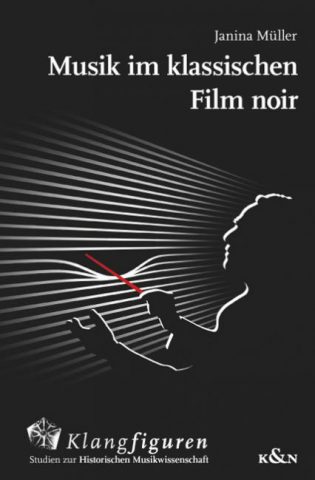Janina Müller’s study (“Music in classic film noir”) takes a close look at the scores of mostly the popular films noir and a few rather unknown ones. Here it means studying, juxtaposing and evaluating the scores of several films, while their uniqueness in comparison with standard Hollywood movies is questioned.
 As there is hardly one working theory for what exactly defines a film noir, a similar theory or set of features for its soundtrack is also unavailable. Many melodramatic love stories or detective movies made by the big studios are clearly not film noirs, while many film noir soundtracks are straightforward “invisible” Hollywood standard compositions, neither particularly dramatic, nor innovative or jazz-influenced. One of her points, however, is to refute the standard idea that the Hollywood film soundtrack of the golden era was, for the most part, strongly influenced by late-romantic musical styles (thus ignoring other influences).
As there is hardly one working theory for what exactly defines a film noir, a similar theory or set of features for its soundtrack is also unavailable. Many melodramatic love stories or detective movies made by the big studios are clearly not film noirs, while many film noir soundtracks are straightforward “invisible” Hollywood standard compositions, neither particularly dramatic, nor innovative or jazz-influenced. One of her points, however, is to refute the standard idea that the Hollywood film soundtrack of the golden era was, for the most part, strongly influenced by late-romantic musical styles (thus ignoring other influences).
To some extent the book also covers and connects the sonic sensations of the genre/style with one of the origins of film noir: many such movies were based on hard-boiled detective novels, i.e. their themes, settings and plots such as the introduction of the femme fatale, the tough and street-wise private investigator and protagonists in extreme and cornered situations, acting under pressure. The majority of the films she analyzes are based on literary woks by either Raymond Chandler, Dashiell Hammett or James M. Cain.
While working with the tools and the vocabulary of a musicologist – the book is the author’s dissertation, a study in historical musicology, so a little command of musical terms like tritone, chromatic turn, or six-four chord on the reader’s side is probably needed – Müller gives very detailed examples of just how composers of films noir used modern technology, such as now available multiple track recordings, new emphasis on noises and the way voices were presented, which lead to different levels of narration, and Hollywood’s fresh interest in psychological disorders or (often war-induced) trauma, states of euphoria or drug intoxication.
Previously unusual musical arrangements like the use of the theremin, twisted organ noises or sound effects that express a distorted state of mind or an inability to grasp situations were suddenly used frequently. Müller sees violent scenes in noirs often initiated by acoustic/musical introductions. She identifies further recurring aspects of the films at hand such as mysterious scenes as topical patterns, harmonious themes serving as nostalgic memories in soundtracks, and melodious allusions to horror or comedy films. However, violence, one of the characteristics of film noir, for centuries was already used as a means of musical style in opera and classical composition; the soundtracks of the 1940s and 1950s simply added certain elements. She gives examples of this in her detailed analysis of particular opening titles or her interpretation of the violent scenes in Brute Force and The Killers when she goes into composition details to introduce particular effects the composers emphasized in a certain scene.
Other significant features of films noir, like the flashback and voice-over commentaries, are also accompanied by music or a theme. Her chapter “Temps perdu,” that concentrates on flashbacks, memories, sounds and melodies that seemingly set into motion certain activity is particularly interesting. There, as in all other chapters, Müller employs original full scores, when available, to demonstrate her points. As examples for her findings on these aspects, she cites scenes and audio from the movies Out of the Past, Angel Face and Possessed.
Throughout she shares expert knowledge of the techniques, sound experiments and creative methods of famous composers such as Miklós Rózsa, Max Steiner, Adolph Deutsch, Roy Webb, George Antheil, and Henry Mancini. Her investigation of the Touch of Evil sound and soundtrack composed by Mancini (including the one Orson Welles would have originally wished for) is very good; needless to say that this movie became a masterpiece also because of its use of music and jazz-inspired extra-diegetic atmosphere.
Ultimately, she sees many different musical sources at work in making the soundtracks of film noir so unique, as they blend into a mix of classical themes and motives from the era of silent film and opera, but also show influences of popular music of the 1950s, traces of Richard Wagner and jazz. (Many audio markers of noirs have been in use by composers since the 1910s, while silent movies used a very different technology and basically different scores, none of which were mysterioso introductions, reappearing themes, and particular topical patterns that represent certain moods inventions of the 1940s).
Keeping in mind the very small number of publications that deal exclusively with the sound or soundtracks of films noir over the last few decades or so, this solid work is really most welcome. Unfortunately, the book has no index. (NB, the text of this book is in German).
Review by Dr. A. Ebert © 2019
Janina Müller. Musik im klassischen Film noir. (Klangfiguren, Vol. 5). Königshausen und Neumann, 2019, 278 p.
